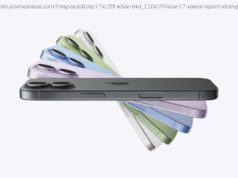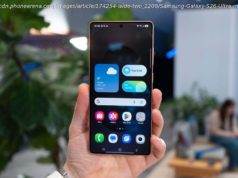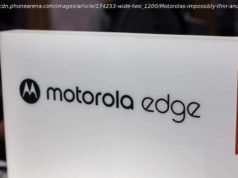At this year’s Mobile World Congress, ZTE is unveiling a few new budget-friendly additions to its smartphone lineup — the Blade V9 and the Tempo Go, an Android Go smartphone.
Following the Blade V8 series, ZTE is offering the next-generation of devices within the Blade family — the Blade V9 and the Blade V9 Vita. The Chinese company made the announcement on Sunday at Mobile World Congress in Barcelona.
In addition to the Blade V9, ZTE also introduced its first Android Go smartphone, called the Tempo Go. Here’s everything you need to know about the ZTE Blade V9 and Tempo Go.
The Tempo Go is a budget smartphone with a simple design. It includes a 5-inch display and comes in with 854 x 480 resolution. At the bottom, you will find both a 3.5mm headphone jack and a MicroUSB charging port.
What is unique about this device is that it runs Google’s new Android Go platform, which is a much smaller size version of Android meant for lower-end phones. It’s capable of running on phones with just 512MB of RAM. Android Go comes with lightweight Google apps that are smaller than 10MB in size, like Gmail Go. Not only that, but it’s the first Android Go-powered phone to come to the U. S.
The Tempo Go is powered by Qualcomm’s Snapdragon 210 chipset, with a battery capacity of 2,200mAh. The phone comes with 8GB of storage, which is expandable to 32GB thanks to a MicroSD card slot, and it only has 1GB of RAM. On the back, there’s a 5-megapixel rear-facing camera and a 2-megapixel front-facing camera.
The phone has a custom version of the Google Play Store integrated, allowing users to download either the lite or full version of apps, depending on their preference. Android Go also includes Google Assistant Go, allowing users to interact with Google’s artificially intelligent assistant.
The Tempo Go is now being sold unlocked on GSM, UMTS, and LTE networks in the U. S. It costs you $80 and is available for purchase on ZTE’s site. As far as color variants, the Tempo Go only comes in the gray model.
The ZTE Blade V9 has a 5.7-inch Full HD+ display with an 18:9 aspect ratio, which provides a longer screen for viewing more content. The edges around the screen have been minimized for a more full-screen design, a trend every smartphone manufacturer is following.
The back of the phone is glass, giving it a more expensive feel. It’s slim, and despite its large size, it feels fairly compact. The back is incredibly minimal, with just the ZTE logo, a fingerprint sensor, and a dual-camera system.
There’s a 3.5mm-headphone jack at the top, and sadly, ZTE opted for a MicroUSB charging port on the bottom. The company said since this phone is primarily meant for markets outside the U. S., there’s not much demand to see USB-Type C in an affordable smartphone.
Under the hood, the Blade V9 is powered by the Snapdragon 450 processor, which performed well in our brief hands-on time with the phone. Apps opened quickly, and moving throughout the operating system was fluid.
Perhaps what’s more impressive, however, is how the Blade V9 does not come installed with ZTE’s MiFavor user interface. No, it runs stock Android 8.1 Oreo. Why did ZTE dump its own software? Because its customers — specifically from the Z Community forum — preferred the bloatware-free, pure version of Android. It’s a big change, and ZTE told Digital Trends it will use stock Android in all its future smartphones, including those in its higher-tier Axon range.
There is hardly any apps pre-installed on the phone, except for a few core Google apps. The user interface is simple, but it’s likely why it’s so fast to react.
The Blade V9 also packs a 3,100mAh battery and comes in a variety of storage options. With the 2GB RAM model, you get 16GB of storage; 3GB of RAM comes with 32GB; and 4GB offers 64GB. There is a MicroSD slot for expandable storage of up to 256GB, as well.
Dual lens cameras aren’t new on ZTE phones, but we’re impressed at the speed and quality from the Blade V9’s camera. A 16-megapixel camera is accompanied with a 5-megapixel one, and the two are capable of taking portrait mode-like selfies. The camera results, in our brief tests, looked good, with solid color accuracy, no blur, and good detail. We’re excited to see how the camera reacts in all sorts of environments, especially because ZTE has improved its low-light image processing with the V9.
As for the front-facing camera, it comes in at 8-megapixels, but 13-megapixels interpolated. That means pixels are added to the image by estimating the new color and intensity. So, even though you’re taking a photo with an 8-megapixel camera, the camera’s software will make it look as though it was taken with 13-megapixels instead. This may not necessarily mean the photo will look better since it’s essentially simulating the higher-resolution.
The ZTE Blade V9 will be available in Spain, Germany, Russia, and Mexico. The Blade Vita is a similar device with slightly different specifications, and it will launch in China with the company’s MiFavor UI instead of stock Android.
As for color options, the Blade V9 comes in four different variants — black, gold, blue, and grey. We likely won’t see the V9 here in the U. S., but ZTE usually works with smaller carriers like MetroPCS and Boost Mobile to bring different versions of the Blade V-series phones. Expect the same for the V9.
Updated on March 30: The ZTE Tempo Go is now available in the U. S.






